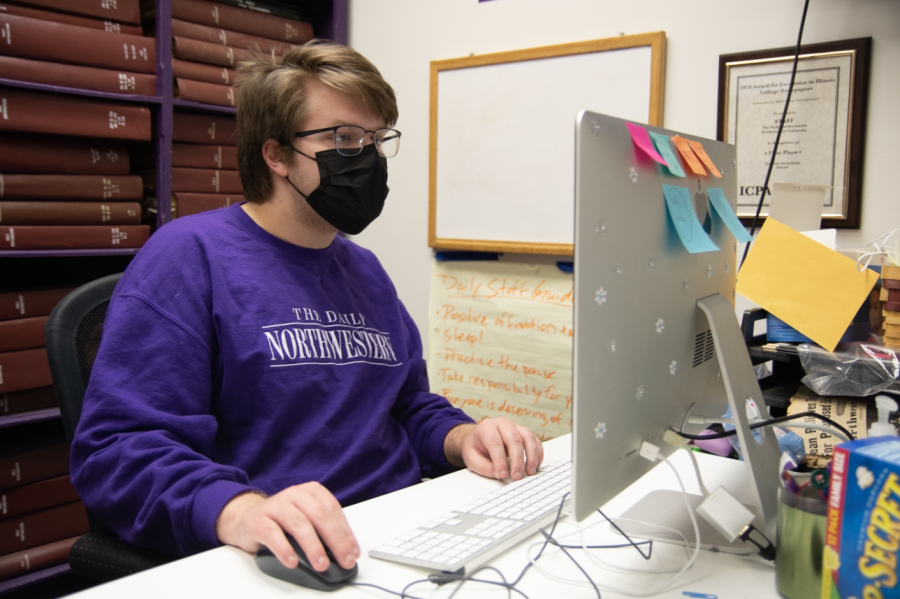From the Newsroom: The stories behind our style guide
Angeli Mittal/Daily Senior Staffer
The Daily’s editors and reporters consult a 63-page stylebook which mixes grammar and style rules with Evanston facts and newsroom discussion points.
May 18, 2022
In this series, Daily staff members hope to provide more transparency about how we operate. If you would like to submit a question to be answered here, please send an email to Editor-in-chief Jacob Fulton at [email protected].
Every Daily story goes through multiple rounds of editors, who check for grammar, flow and content to different extents. As content is shaped and reshaped, our style guide becomes important not only for keeping our stories clean, tight and consistent, but also in making sure reporters share background knowledge on pertinent campus and city issues.
The Daily Northwestern Stylebook and Ethics Guide is a 63-page living document based primarily on Associated Press style with a few Evanston- and Northwestern-specific additions. While our copy desk is responsible for inputting style edits, all members of our edit board can access the document and can check it throughout the night. The AP Stylebook tells us what to do with dates, times, numbers and addresses — but not what to do with the full title, for example, of Evanston/Skokie School District 65.
Over the years, copy editors have added entries on each student group and its specialty. For instance, if you read the stylebook, you would learn members of the a capella group X-Factors wear pink and don’t compete, while the Undertones wear blue and performed at the White House in 2016. There are also notes on each campus building, updated yearly as functionality changes and residence halls are shuffled.
The ethics guide also includes reminders about best practices for reporting. Reporters can refer to the guide for advice on how to source ethically on a campus full of peers, how to gather identity metrics from sources and how to write content warnings on articles with sensitive topics, among other guidelines.
When I was copy editor in Spring Quarter 2021, my co-editor Nick Francis and I overhauled the guide. As students protested for the abolition of city and campus police and Greek life chapters, as well as for support of sexual assault survivors, we felt it was more important than ever for reporters to be thoughtful reporting on issues they may not have covered before.
To help reporters, we included short blurbs on our coverage history. The Abolish Greek Life entry, for example, briefly discusses the history of the related Instagram page established anonymously in summer 2020.
These blurbs are not limited to on-campus issues. The stylebook entry on Tax Increment Financing districts includes a short history of debates in Evanston about whether TIF funding spurs gentrification.
Putting increased context in the stylebook was our way to ensure history and sensitivity were unilaterally highlighted in reporting. This was a big undertaking and became a continued project; Winter Quarter 2022 copy editors Joanna Hou and Nicole Markus continued where we left off.
The main Daily Stylebook works in tandem with smaller style guides dedicated to sports reporting and identities reporting. In updating our own language and guidelines each quarter, we consult consistently with standards and recommendations set by organizations including the National Association of Black Journalists, the National Association of Hispanic Journalists, the Asian American Journalists Association, the Association of LGBTQ Journalists and the Trans Journalists Association.
Some of our longer, explanatory entries are the product of conversations we’ve had in the newsroom. We have discussed and decided on Daily style for using the terms Latine vs. Latinx and Latino/a, addressing deadnames and misgendering in interviews and ensuring correct detailed inclusion of Indigenous sources’ tribal affiliations, as applicable.
By fusing newsroom discussions and campus lore, The Daily’s style guide says a lot more about our coverage than our grammar smarts. (RIP to the Oxford comma, though.)
Email: @ilana_arougheti
Twitter: [email protected]
Related Stories:
— From The Newsroom: The Daily’s corrections and fact-checking process, explained
— From the Newsroom: How to pitch The Daily a story idea, and how we decide what news to cover


